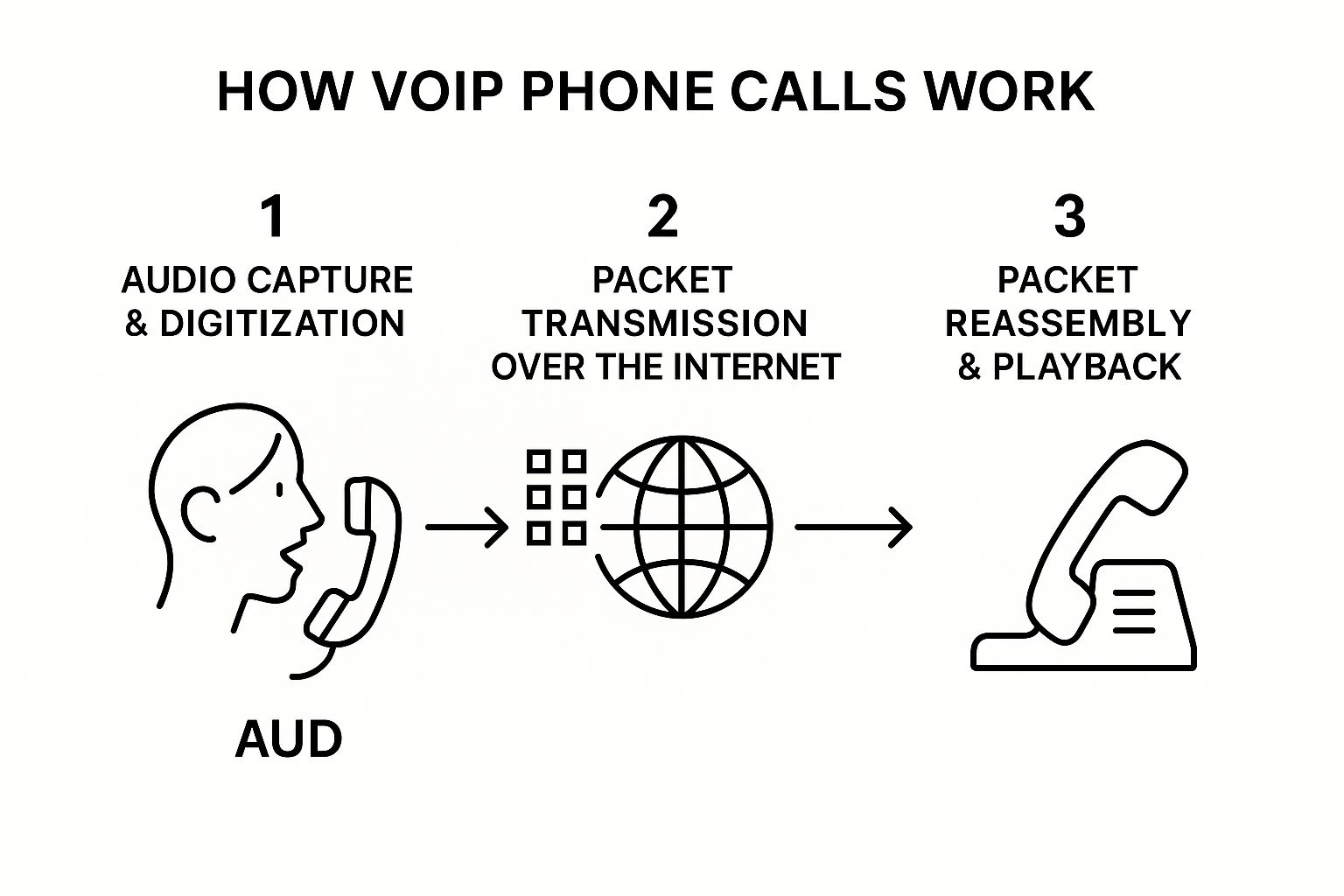VoIP phone calls are what happen when your business phone system finally catches up with the rest of your technology. Instead of relying on old-school copper wires, VoIP converts your voice into digital packets and sends them over the internet—the same network you use for everything else. This simple shift unlocks huge gains in flexibility and often leads to significant cost savings.
A Closer Look at How VoIP Phone Calls Work

Think of it this way: a traditional phone call is like a direct train on a dedicated track. It can only go from one specific station to another. VoIP phone calls, on the other hand, are more like a modern delivery service.
Your voice is broken down into tiny, secure data packets. Each packet is intelligently routed across the internet, finding the most efficient path to its destination. When they arrive—milliseconds later—they're reassembled in perfect order, so the person on the other end hears your voice in crystal-clear quality.
This switch from analogue signals to digital data is the game-changer. It frees your communication from being tied to a physical line in a specific building, opening up a whole new world of features and possibilities.
The Real-World Impact on Your Business
For any organization, especially here in the UAE, moving to VoIP isn't just a minor tech upgrade; it's a strategic business decision. Internet-based calling has quickly become the gold standard for companies that need to be agile and scalable.
The push to adopt this technology comes down to a few core benefits:
- Lower Operating Costs: You use the internet connection you're already paying for, which means you can ditch expensive, dedicated phone lines and see a huge drop in your international call bills.
- True Mobility: Your team can make and take calls on their business number from anywhere. Whether they're at their desk, using a software-based "softphone" on their laptop, or on their mobile, they're always connected.
- Powerful Built-in Features: Advanced tools like auto-attendants (IVR), smart call forwarding, and in-depth analytics come standard, not as costly extras.
We're seeing this shift play out across the region. The Middle East and Africa (MEA) now represent over 1% of global VoIP revenue, and the market is expected to grow at a 10.4% compound annual growth rate (CAGR), with the UAE’s robust infrastructure leading the way. You can explore more about the regional VoIP service market to see the numbers behind this trend.
To give you a clearer picture, here’s a simple breakdown of how VoIP stacks up against the old way of doing things.
Traditional Phone Calls vs. VoIP Phone Calls at a Glance
This table offers a quick comparison, highlighting the fundamental differences between old-school landlines and modern VoIP systems.
| Feature | Traditional Landline | VoIP System |
|---|---|---|
| Underlying Tech | Analogue signals over dedicated copper wires (PSTN) | Digital data packets over the internet |
| Infrastructure | Requires physical phone lines installed on-site | Uses your existing internet connection |
| Cost Structure | Per-line rental fees, plus per-minute call charges | Monthly per-user subscription, often with unlimited calls |
| Key Features | Basic calling, voicemail, caller ID (often as add-ons) | Advanced features included (IVR, call recording, etc.) |
| Scalability | Adding lines is slow and expensive | Add or remove users instantly through a web portal |
| Geographic Limits | Tied to a physical location | Completely location-independent |
The difference is clear. VoIP is built for the way we work today—flexible, data-driven, and not tied to a single office.
This guide will cut through the technical noise and give you a straightforward look at how your business can get ahead by implementing Voice over IP in Dubai.
How a VoIP Call Travels Across the Internet
Ever wonder what actually happens when you speak into your phone and someone across the world hears you? The journey your voice takes during VoIP phone calls is a fascinating, high-speed trip that turns sound waves into digital information zipping across the globe in an instant.
It’s not magic, but it’s close. This whole process—from analog sound to digital data and back again—unfolds in the blink of an eye, enabling the seamless, real-time conversations that businesses depend on.
From Analog Voice to Digital Packets
It all starts with your voice. When you speak, you create analog sound waves. Your VoIP device, whether it's a desk phone or a software app, captures these waves and immediately gets to work, converting them into digital code. This conversion is handled by a crucial component called a codec (short for coder-decoder).
Think of a codec as an expert packer for your voice. Its main job is to compress the digital audio into small, efficient chunks called data packets. This compression is key, as it dramatically reduces the amount of internet bandwidth needed without compromising on clarity. The result? VoIP phone calls that are both efficient and crystal clear.
This infographic breaks down the core journey of a VoIP call from start to finish.

As you can see, the system captures your voice, breaks it down into packets for its internet journey, and then perfectly reassembles it for the person on the other end.
The Rules of the Road: SIP and RTP
Once your voice is all packaged up, it needs directions. This is where a couple of specialized internet protocols come into play, acting like a sophisticated traffic management system for your call.
You'll often hear about two protocols in particular:
- SIP (Session Initiation Protocol): Think of SIP as the traffic controller that starts and ends the call. When you dial, SIP sends out a message to find the person you're trying to reach and set up the connection. It’s basically asking, "Hey, I'd like to start a call. Are you available?"
- RTP (Real-time Transport Protocol): As soon as the call connects, RTP takes the wheel. It's responsible for the actual delivery of the voice packets, making sure they travel across the internet efficiently and are put back together in the right order on the other side.
These two protocols work hand-in-hand. SIP sets up the session, and RTP handles the live conversation. It's this teamwork that makes reliable, real-time communication over the internet possible.
The core function of these protocols is to ensure reliability. They turn the vast, sometimes chaotic, public internet into a dependable network for business-critical conversations, managing everything from call setup to final delivery.
Reassembly for a Clear Conversation
When the data packets arrive at their destination, the journey simply reverses. The recipient's VoIP device uses its own codec to decompress and reassemble the packets into a smooth, continuous audio stream. That digital stream is then instantly converted back into analog sound waves they hear through their speaker or headset.
This entire sequence—digitization, packetization, transmission, and reassembly—happens so fast that the conversation feels completely natural. A well-designed network makes sure packets arrive with minimal delay (latency) and in a consistent stream (low jitter), which are the true secrets behind high-definition voice quality. Understanding this digital journey makes it clear why a stable internet connection is the bedrock of great VoIP performance.
Achieving Crystal-Clear VoIP Call Quality

When it comes to business communications, call quality isn't just a feature—it's everything. Choppy audio, dropped calls, and frustrating echoes can instantly damage a client's perception and grind your team's productivity to a halt. With VoIP phone calls, the clarity of every conversation hinges entirely on the health of your internet connection.
Unlike an old-school landline that gives you a dedicated copper wire, VoIP has to share its internet connection with everything else your business does online. We're talking email, file downloads, video conferences—you name it. Getting a handle on the factors that influence this shared environment is the first step to making sure every call sounds professional.
The Three Pillars of VoIP Call Quality
There are really only three technical metrics that make or break how your VoIP phone calls sound. Let's break down what they are and what they actually mean for your day-to-day conversations.
-
Bandwidth: Think of this as the total number of lanes on your internet highway. If you don't have enough bandwidth, your voice data gets stuck in a traffic jam with all the other data. This is what causes that garbled, underwater sound, especially when lots of people are online at once.
-
Latency: This is the time it takes for a little packet of your voice data to get from your phone to the person you're talking to. High latency is what creates that awkward delay or echo, making conversations feel stilted as you accidentally talk over each other.
-
Jitter: This one sounds technical, but it’s simple: jitter is just the variation in when those voice packets arrive. If they show up out of order, the phone on the other end struggles to piece the conversation back together. The result? Jumbled, robotic-sounding speech.
If any one of these three pillars is weak, the entire call experience suffers. For a genuinely high-quality call, network performance studies suggest you need latency to stay below 150 milliseconds and jitter under 30 milliseconds.
Prioritizing Your Voice Traffic with QoS
So, how do you stop a massive file download from torpedoing your most important sales call? The answer is a network strategy called Quality of Service (QoS).
QoS essentially creates a VIP express lane on your internet highway, reserved only for your voice data. When you set up QoS rules on your network router, you're telling it to always let VoIP packets go to the front of the line, ahead of less time-sensitive traffic like emails or web browsing.
QoS is the single most effective tool for ensuring a consistently professional calling experience. It tells your network, "No matter what else is going on, these voice conversations are the priority," which stops other applications from hogging all the bandwidth.
This simple act of prioritization gives your VoIP phone calls the resources they need, preventing the lag and poor audio that plague so many businesses on a busy network.
Steps to Assess Your Network Readiness
Before you go all-in on a VoIP system, it's critical to make sure your network is actually ready for it. A little proactive assessment now will save you from a world of headaches down the road.
- Run a VoIP Speed Test: Don't just use a standard speed test. Find an online tool specifically built to measure latency and jitter. These tools simulate VoIP traffic, giving you a much more accurate picture of how your network will perform under real-world calling conditions.
- Analyze Your Current Usage: Get a feel for your peak internet hours. Are there certain times of day when your network is already stretched thin? Knowing this will help you decide if you need to bump up your internet plan.
- Check Your Router: Make sure your router can handle QoS settings. Most modern, business-grade routers have this built-in, but older or consumer-grade models might lack this essential feature for properly managing VoIP phone calls.
Choosing Your VoIP Deployment Model
Deciding how to set up your VoIP system is one of the most important calls you'll make for your business communications. This isn't just a technical choice; it's a strategic one that will shape your budget, the demands on your IT team, and your ability to adapt down the road. The decision really comes down to two main paths for handling your VoIP phone calls.
You can go the traditional route and build it all yourself with an on-premise Private Branch Exchange (PBX), or you can partner with a provider who runs everything for you in the cloud. The best analogy is owning a house versus renting an apartment. Owning gives you total control, but you're on the hook for every repair and upgrade. Renting means the landlord handles all that, giving you predictable costs and less hands-on work.
Each approach has its own set of pros and cons when it comes to cost, control, and the ability to grow. Let's break them down so you can match your communications strategy to what your business really needs.
The On-Premise PBX Model
With an on-premise PBX, you physically own and house all the equipment. The server that acts as the brain of your phone system is right there in your office, giving you direct, granular control over every setting, security protocol, and custom feature you can dream up.
Of course, that level of control doesn't come free. It requires a pretty hefty upfront investment to buy the servers, handsets, and all the other gear. Beyond the initial purchase, the responsibility for all maintenance, security patches, and troubleshooting falls squarely on your shoulders.
- Initial Investment: High. You're buying all the hardware from day one.
- Ongoing Costs: Monthly service fees are low, but you'll need skilled IT staff to manage the system.
- Control: Absolute. You have the final say on every aspect of configuration and security.
- Scalability: It can be a real headache. Adding more users often means buying more expensive hardware.
This model tends to be the best fit for larger organizations with dedicated IT departments and highly specific security or integration requirements that justify the hands-on approach.
The Cloud-Hosted VoIP Model
On the other side of the coin is the cloud-hosted model, which you'll often hear called Unified Communications as a Service (UCaaS). Here, you're essentially subscribing to a service. A specialized provider owns and operates all the complex technology in their secure data centers, and you just connect to it over the internet.
This completely flips the financial model, turning a large capital expense (CapEx) into a predictable monthly operating expense (OpEx). All the backend work—maintenance, security, and software updates—is handled by the provider. This frees up your IT team to focus on projects that directly drive your business forward.
The move to the cloud is a major reason why the Middle East & Africa region now accounts for 6.8% of the global VoIP market. Advanced digital infrastructure in places like the UAE makes it easy for businesses to adopt these solutions to cut costs and better support hybrid workforces. For a deeper dive, you can explore the regional VoIP market's growth and see what's driving this trend.
A cloud-hosted system fundamentally changes the ownership model. Instead of buying and maintaining a complex asset, you are subscribing to a constantly evolving service, ensuring you always have access to the latest features and security without any additional capital investment.
This model is built for flexibility. Need to add ten new employees? Just adjust your subscription. It’s that simple. It has become the default choice for most small and mid-sized businesses, as well as larger companies that value agility and want a lower total cost of ownership for their VoIP phone calls.
To make the decision clearer, it helps to see the two models laid out side-by-side.
On-Premise vs. Cloud-Hosted VoIP: A Strategic Comparison
This table compares the two primary VoIP deployment models across key business criteria to help organizations make an informed decision.
| Consideration | On-Premise PBX | Cloud-Hosted PBX (UCaaS) |
|---|---|---|
| Initial Cost | High (Capital Expenditure – CapEx) for hardware and software licensing. | Low (Operating Expenditure – OpEx) with minimal to no upfront cost. |
| Ongoing Costs | IT staff salaries, maintenance contracts, software updates, and electricity. | Predictable monthly subscription fee per user. |
| Control & Customization | Complete control over system configuration, security, and integrations. | Limited to the features and integrations offered by the provider. |
| Maintenance & IT Burden | Full responsibility rests on your in-house IT team. | Provider handles all maintenance, updates, and security. |
| Scalability | Complex and expensive; often requires purchasing new hardware to add capacity. | Simple and instant; add or remove users by adjusting your subscription plan. |
| Feature Updates | Requires manual installation and may involve additional costs for new features. | Automatic; you get access to the latest features as soon as they are released. |
| Best For | Large enterprises with specific security needs and dedicated IT resources. | SMBs and enterprises seeking flexibility, lower TCO, and minimal IT overhead. |
Ultimately, the right choice depends on your organization's unique circumstances—your budget, your IT capabilities, and your vision for the future.
Integrating VoIP With Key Business Tools

A modern communication system should never be an island. The real value of VoIP phone calls is unleashed when your system stops being just a phone and starts acting as an intelligent hub connected to your most critical business software. When your phone system and other applications are in sync, manual tasks melt away, and your team gains powerful new insights.
Picture this: your phone rings. Instead of just a number, your agent’s screen instantly populates with the caller's entire history—their name, recent purchases, and any open support tickets. This isn't science fiction; it’s what happens when you integrate your VoIP platform with your Customer Relationship Management (CRM) system.
This synergy transforms every call from a simple transaction into a well-informed, personal interaction. It completely eliminates the dreaded "let me pull up your account" delay, helping your team provide faster, smarter service that builds real customer loyalty.
The Power of CRM and VoIP Integration
Connecting your VoIP system to a CRM like Salesforce, Zoho, or HubSpot creates a unified command center for every customer touchpoint. This isn't just a matter of convenience; it’s a fundamental upgrade to how your team operates, driving efficiency and dramatically improving the customer journey.
Here are just a few of the immediate benefits:
- Automatic Call Logging: Every inbound and outbound call is automatically logged in the customer's CRM profile. This simple automation saves countless hours of manual data entry and ensures no detail ever slips through the cracks.
- Screen Pops for Inbound Calls: An incoming call triggers a "screen pop," instantly displaying the caller’s full CRM record. Your agents have complete context before they even say hello.
- Click-to-Dial Functionality: Your team can make VoIP phone calls directly from the CRM with a single click. This small feature significantly cuts down on dialing errors and speeds up the workflow for sales and support staff.
Integrating VoIP with your CRM turns your communication system into a powerful data-gathering tool. It ensures that every customer touchpoint contributes to a richer, more detailed understanding of their needs and history, directly fueling better business decisions.
How APIs Make Integration Possible
So, what’s the magic behind this seamless connection? It's the Application Programming Interface (API). Think of an API as a secure messenger that allows two different software programs to talk to each other and share information based on a set of clear rules.
A VoIP provider with a robust and well-documented API gives you the flexibility to build custom connections to the tools your business already depends on, whether it's your CRM, a helpdesk platform, or even specialized industry software. For businesses in the UAE, choosing a provider with extensive integration capabilities is key to building a truly connected and data-driven operation. You can dive deeper into our guide on making VoIP calls in Dubai for more local insights.
This ability to connect systems is no longer a luxury but a core requirement for any business looking to boost efficiency and deliver a stellar customer experience. By making your VoIP phone calls part of a larger, interconnected workflow, you give your team the information they need to perform at their absolute best.
Securing Your VoIP Communications
https://www.youtube.com/embed/Iq9KZh5bylw
Shifting your business calls to the internet is a fantastic move for efficiency, but it does mean you have to think about security in a new way. When your VoIP phone calls travel across the same networks as your other data, they're exposed to risks that just weren't a factor with old analog phone lines. Keeping those conversations private isn't just a good idea—it's essential for protecting client confidentiality and your company's reputation.
The great thing is, you don't have to be a security expert to lock things down. Most of the threats you'll face fall into two main categories: eavesdropping (someone listening in on your calls) and toll fraud (hackers hijacking your system to make expensive international calls on your dime). Luckily, any modern VoIP platform worth its salt has powerful tools built right in to fight these problems.
The heart of VoIP security is encryption. The simplest way to think about it is like creating a secure, private tunnel for your call data to travel through. Even if a bad actor managed to grab the data packets from your call, they'd just see a jumbled, useless mess of code.
Understanding Key Encryption Protocols
Building that secure tunnel relies on a couple of key technologies working in tandem. You don't need to be a network engineer, but knowing what they are and what they do helps you ask the right questions when evaluating a VoIP provider.
Here are the two security layers you need to know about:
-
Transport Layer Security (TLS): This protocol is all about securing the setup of the call. It encrypts the signaling data—things like who is calling whom and the commands to start or end the call. This stops anyone from hijacking or tampering with the connection before it even begins. You can learn more about how this works by checking out our guide to securing calls with SIP over TLS.
-
Secure Real-time Transport Protocol (SRTP): As soon as the call connects, SRTP kicks in. Its job is to encrypt the actual audio of the conversation. This is the protocol that ensures the content of your VoIP phone calls can't be intercepted and understood by unauthorized parties.
When a provider offers both TLS and SRTP, you're getting what's known as end-to-end encryption. This is the industry standard for truly secure business communications.
Combining these protocols creates a seriously fortified communication channel. Think of TLS as the security guard at the door checking IDs, and SRTP as the soundproof room that keeps the conversation inside completely private.
Adopting Network Security Best Practices
Encryption is critical, but how you manage your own network is just as important for keeping your calls safe. A simple shift in mindset helps: treat your voice data with the same level of care as you do your sensitive financial or customer records.
A bit of good network hygiene goes a long way in preventing most security headaches. Here are a few key practices:
-
Configure Firewalls: Your firewall is your first line of defense. It needs to be set up to allow traffic from your VoIP provider while blocking everything else that looks suspicious or unrecognized.
-
Use VLANs: A Virtual Local Area Network (VLAN) is a way to digitally separate parts of your network. By putting all your VoIP phone calls on their own dedicated VLAN, you isolate them from your regular data traffic. This dramatically reduces their exposure to any potential threats that might already be on your network.
-
Enforce Strong Passwords: It's almost cliché, but it's true: a shocking number of security breaches come down to weak or default passwords. Make sure a strong password policy is in place for all user accounts and especially for any administrator access.
Answering Your Top Questions About VoIP
Whenever a business thinks about changing its communication system, plenty of questions pop up. It's only natural. For companies across the UAE looking at VoIP phone calls, getting clear, practical answers is the first step. Let's tackle the most common queries head-on to demystify the technology and its real-world impact on your daily operations.
Making a smart decision starts with good information. Once you understand these key points, you'll be in a much better position to pick the right solution for your team.
Do I Really Need a Special Phone for VoIP?
Not always, and that’s one of its biggest perks. While dedicated IP desk phones are built to give you the best possible experience, you’ve got plenty of other flexible options for your team.
- Keep Your Current Phones: An Analog Telephone Adapter (ATA) acts as a bridge, connecting your traditional office phones to the VoIP network. This lets you keep hardware everyone is already comfortable with.
- Use a Computer: Most VoIP providers have "softphone" apps. This is simply a piece of software that turns any laptop or desktop into a phone, letting you make calls with a headset.
- Use a Mobile Device: With a dedicated mobile app, any smartphone can become a full-fledged business line. It's perfect for remote workers or anyone who travels for work.
This kind of flexibility is a massive plus for businesses navigating the needs of a modern, hybrid workforce.
What Happens if My Internet Goes Down?
This is a make-or-break question for any business that depends on the internet. While a local outage will certainly impact office-based IP phones, modern cloud-based VoIP phone calls are built for exactly this scenario.
Good systems have built-in business continuity features. You can set up call forwarding rules that automatically kick in if your office network goes offline. All incoming calls can be instantly rerouted to pre-selected mobile numbers or even another branch. This simple feature ensures you never miss a critical client call, even when things go wrong.
A well-planned VoIP setup has resilience built in. The power to automatically failover to mobile phones means your business stays open, protecting both your revenue and your reputation.
Is VoIP Really Cheaper Than a Traditional Phone Line?
For almost every business in the UAE, the answer is a clear and simple yes. The savings aren't just a few dirhams here and there; they come from a complete change in how you pay for calls.
Instead of being locked into high monthly fees for physical lines and paying a fortune for international calls, VoIP works on a predictable, per-user subscription. This plan often includes unlimited local calling and drastically lower international rates. Since you're using the internet connection you already pay for, you also get to skip the costs of installing and maintaining a separate network of phone wiring. It all adds up to significant long-term savings.
The drive for more efficient, cost-effective tools is fueling major growth. In fact, the VoIP Telephony market in the Middle East & Africa grew by around 20% last year. The UAE is at the forefront of this trend, with companies in finance, healthcare, and IT leading the way to cut down on operational costs. You can dig deeper into these VoIP telephony market trends to see the full picture.
Is VoIP Voice Quality as Good as a Landline?
It absolutely can be. With a stable internet connection that’s been properly set up, the quality of VoIP phone calls can easily match, or even beat, a traditional landline. Many providers now use High-Definition (HD) Voice technology, which captures a much wider spectrum of sound for conversations that are richer, clearer, and more natural.
The one thing that matters most for call quality is your network. The secret to a flawless, professional audio experience is making sure you have enough bandwidth and that your network is configured to prioritize voice traffic—something usually done with Quality of Service (QoS) settings.
Ready to transform your business communications? Cloud Move offers customized, enterprise-grade telephony solutions that integrate seamlessly with your key business tools. Discover how our cloud, on-premise, and hybrid deployments can enhance efficiency and customer engagement. Schedule your free demo with us today!




